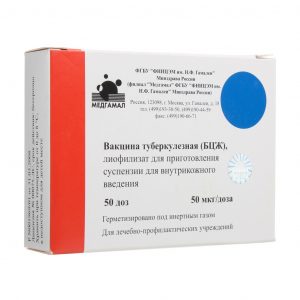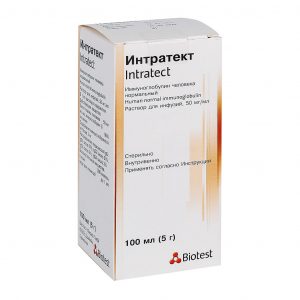Description
Release form
Lyophilisate for preparation of solution for infusions
Packaging
1 bottle complete with syringe.
Indications
– to reduce symptoms, enhance clinical response, inhibiting the progression of structural damage and improving functional activity in adult patients with moderate to severe active rheumatoid arthritis with insufficient response to one or more basic anti-inflammatory (such as methotrexate) or biological anti-rheumatic drugs
– to reduce the manifestations and symptoms in children aged 6 years and older with a mild or severe course of active juvenile idiopathic arthritis with multiple joint damage.
Contraindications
– combined use with TNF blockers
– severe uncontrolled infections (sepsis, opportunistic infections), active infections (including tuberculosis) until control is established
– pregnancy
– lactation (breastfeeding) children’s age up to 6 years
– hypersensitivity to the components of the drug.
Caution should be used in patients with recurrent infections, conditions predisposing to infections (diabetes mellitus), hepatitis in elderly patients. Abatacept should be discontinued if an infectious disease develops.
Special instructions
When prescribing immunomodulating drugs, a tuberculin skin test should be performed to detect the presence of tuberculosis infection. Abatacept was not used in patients with a positive tuberculin breakdown, therefore, the safety of the drug in patients with latent tuberculosis is unknown. With a positive reaction, before the appointment of abatacept, it is necessary to carry out standard anti-tuberculosis therapy.
No live vaccines should be used during abatacept treatment and for 3 months after withdrawal. Medicines that affect the immune system, including abatacept, can reduce the effectiveness of vaccinations.
It is possible to obtain false-positive results when determining the level of blood glucose on the day of drug administration using tests based on glucose dehydrogenase-pyrroloquinolinquinone due to the reaction with maltose contained in the drug. If glucose determination is required, methods that exclude the reaction with maltose should be used.
Composition
Active ingredient: abatacept 250 mg
Excipients: maltose monohydrate, sodium dihydrogen phosphate monohydrate, sodium chloride, hydrochloric acid, sodium hydroxide.
Dosage and administration
Abatacept can be used as monotherapy or in combination with basic anti-inflammatory drugs (for example, methotrexate).
Orencia® is administered iv in the form of infusion for 30 minutes at the doses indicated in the table.
Adults after the first injection, it is recommended that the following doses be administered after 2 and 4 weeks, and then every 4 weeks.
Body weight Dose Number of vials
<60kg 500 mg 2 60-100 kg 750 mg 3 > 100 kg 1 g 4
For children aged 6 to 17 years with a body weight of less than 75 kg, the dose is 10 mg / kg body. The dose should be calculated individually immediately before each administration of the drug. For children with a body weight of 75 kg or more, the dosage regimen of the drug is the same as for adults. The maximum dose is 1000 mg.
Rules for the preparation of the infusion solution and administration of the drug
The abatacept solution cannot be used with equipment incorporating silicone.
After removing the protective plastic cover, wipe the stopper with sterile cotton soaked in alcohol. The contents of one bottle are dissolved in 10 ml of water for injection using a disposable silicone-free syringe that is included with the drug (a stream of water should be directed to the wall of the bottle when the drug is dissolved). To reduce the formation of foam, the vial should be carefully rotated until the powder is completely dissolved. Do not shake! After dissolving the powder from the vial, bleed air through the needle to remove any bubbles that might have formed. The resulting concentrate should be colorless or pale yellow. Do not use a cloudy solution, a solution of a different color or containing foreign particles.
The resulting concentrate is immediately diluted to 100 ml with 0.9% sodium chloride solution for injection to obtain an infusion solution as follows: 10 ml of solution for each added vial of abatacept is taken from a 100 ml bottle with sodium chloride. Then, the previously obtained concentrate is slowly added to the remaining solution using a disposable silicone-free syringe included in the preparation. The abatacept concentration in the resulting solution is approximately 5, 7.5 or 10 mg / ml, respectively, using 2, 3 or 4 vials of the drug.
Ready solution can be stored for 24 hours in a refrigerator at a temperature of 2 ° to 8 ° C. If foreign particles or discoloration are observed in the solution before administration, the solution must be poured. The prepared solution must be administered within 24 hours after opening the bottle.
The prepared infusion solution is administered for 30 minutes through the infusion system with a sterile pyrogen-free filter with a low ability to bind proteins (pore size from 0.2 to 1.2 ?m). Abatacept can not be administered simultaneously with other drugs through a single infusion system.
Side effects
Infections and infestations: often lower respiratory tract infections (including bronchitis), urinary tract infections, herpes simplex and herpes zoster, upper respiratory tract infections (including tracheitis, nasopharyngitis), rhinitis sometimes – tooth infections, infected skin ulcers, onychomycosis.
Benign and malignant tumors: rarely – basal cell skin cancer, lung cancer, lymphoma, myelodysplastic syndrome.
From the hemopoietic system: sometimes – thrombocytopenia, leukopenia.
From the side of the central nervous system and peripheral nervous system: very often – headache often – sometimes vertigo – depression, anxiety, paresthesia.
From the side of the organ of vision: sometimes – conjunctivitis, decreased visual acuity, dry eye.
From the cardiovascular system: often – arterial hypertension, sometimes hot flashes – tachycardia, bradycardia, palpitations, fever, decreased blood pressure.
From the respiratory system: often – cough, exacerbation of COPD, shortness of breath sometimes – bronchospasm, sore throat.
From the digestive system: often – abdominal pain, diarrhea, nausea, dyspepsia, deviations of laboratory parameters of liver function (including increased activity of transaminases), sometimes – gastritis, ulceration of the oral mucosa, aphthous stomatitis.
Dermatological reactions: often – a rash (including dermatitis), sometimes – bruising, alopecia, dry skin, psoriasis.
From the musculoskeletal system: sometimes – arthralgia, pain in the limbs.
From the reproductive system: sometimes – amenorrhea.
Other: often – fatigue, asthenia, sometimes – flu-like syndrome, weight gain.
Drug Interactions
In Patients those who received abatacept with TNF blockers had serious infections more often than those who received only TNF blockers. The combination of abatacept with TNF blockers is not recommended.
Safety and efficacy information for the combination of abatacept with anakinra or rituximab is not enough, therefore such combinations are not recommended.
Abatacept has not been studied in combination with drugs that cause a decrease in the number of lymphocytes. With this combination, it is possible to potentiate the effect of abatacept on the immune system.
Overdose
Orencia ® is administered as an iv infusion under medical supervision. At doses up to 50 mg / kg, no obvious toxic effects were observed. Symptoms of an overdose are not described.
Treatment: in case of an overdose, it is recommended that you observe a doctor and, if necessary, conduct symptomatic therapy.
Storage conditions
The product should be stored out of the reach of children, protected from light, at 2 ° to 8 ° C.
Term hodnosty
3 years
Active substance
Abatacept
lekarstvennaja form
Solution for infusion
Bristol-Myers Squibb, USA




